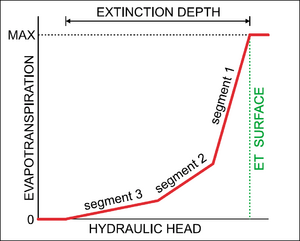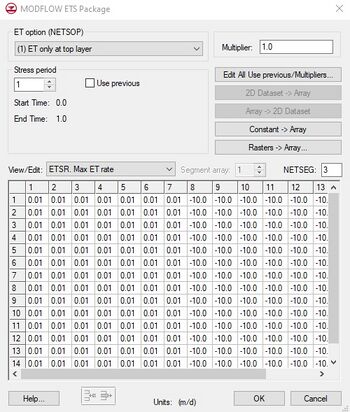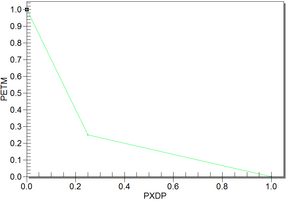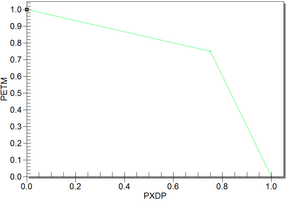GMS:ETS Package: Difference between revisions
From XMS Wiki
Jump to navigationJump to search
No edit summary |
|||
| Line 15: | Line 15: | ||
[[File:MODFLOW-ETS.jpg|thumb|350 px|The ''MODFLOW ETS Package'' dialog.]] | [[File:MODFLOW-ETS.jpg|thumb|350 px|The ''MODFLOW ETS Package'' dialog.]] | ||
From the package documentation: | From the package documentation: | ||
<blockquote style="margin-top:0px; margin-bottom:0px;">In the ETS1 Package, the functional relation of evapotranspiration rate to head is conceptualized as a segmented line in the variable interval. The segments that determine the shape of the function in the variable interval are defined by intermediate points where adjacent segments join. The ends of the segments at the top and bottom of the variable interval are defined by the ET surface, the maximum evapotranspiration rate, and the extinction depth. The number of intermediate points that must be defined is one less than the number of segments in the variable interval. For each intermediate point, two values, PXDP and PETM, are entered to define the point. PXDP is a proportion (between zero and one) of the extinction depth, and PETM is a proportion of the maximum evapotranspiration rate. PXDP is 0.0 at the ET surface and is 1.0 at the bottom of the variable interval. PETM is 1.0 at the ET surface and is 0.0 at the bottom of the variable interval. Segments are numbered such that segment one is the segment with its upper endpoint at the ET surface, and segment numbers increase downward. The relation of evapotranspiration rate to head is defined over the model grid by a series of two-dimensional arrays; therefore, PXDP and PETM also are specified as arrays.<ref name="ofr00-466"/></blockquote> | |||
<blockquote>In the ETS1 Package, the functional relation of evapotranspiration rate to head is conceptualized as a segmented line in the variable interval. The segments that determine the shape of the function in the variable interval are defined by intermediate points where adjacent segments join. The ends of the segments at the top and bottom of the variable interval are defined by the ET surface, the maximum evapotranspiration rate, and the extinction depth. The number of intermediate points that must be defined is one less than the number of segments in the variable interval. For each intermediate point, two values, PXDP and PETM, are entered to define the point. PXDP is a proportion (between zero and one) of the extinction depth, and PETM is a proportion of the maximum evapotranspiration rate. PXDP is 0.0 at the ET surface and is 1.0 at the bottom of the variable interval. PETM is 1.0 at the ET surface and is 0.0 at the bottom of the variable interval. Segments are numbered such that segment one is the segment with its upper endpoint at the ET surface, and segment numbers increase downward. The relation of evapotranspiration rate to head is defined over the model grid by a series of two-dimensional arrays; therefore, PXDP and PETM also are specified as arrays.<ref name="ofr00-466"/></blockquote> | |||
The input order of the arrays defining the segmented line is important and is defined in the package documentation: | The input order of the arrays defining the segmented line is important and is defined in the package documentation: | ||
<blockquote style="margin-top:0px; margin-bottom:0px;">PXDP-is a proportion of the extinction depth (dimensionless), measured downward from the ET surface, which, with PETM, defines the shape of the relation between the evapotranspiration rate and head. The value of PXDP must be between 0.0 and 1.0, inclusive. Repetitions of PXDP and PETM are read in sequence such that the first occurrence represents the bottom of the first segment, and subsequent repetitions represent the bottom of successively lower segments. Accordingly, PXDP values for later repetitions (representing lower segments) should be greater than PXDP values for earlier repetitions. | |||
<blockquote>PXDP-is a proportion of the extinction depth (dimensionless), measured downward from the ET surface, which, with PETM, defines the shape of the relation between the evapotranspiration rate and head. The value of PXDP must be between 0.0 and 1.0, inclusive. Repetitions of PXDP and PETM are read in sequence such that the first occurrence represents the bottom of the first segment, and subsequent repetitions represent the bottom of successively lower segments. Accordingly, PXDP values for later repetitions (representing lower segments) should be greater than PXDP values for earlier repetitions. | |||
PETM-is a proportion of the maximum evapotranspiration rate (dimensionless) which, with PXDP, defines the shape of the relation between the evapotranspiration rate and head. The value of PETM should be between 0.0 and 1.0, inclusive. Repetitions of PXDP and PETM are read in sequence such that the first occurrence represents the bottom of the first segment, and subsequent repetitions represent the bottoms of successively lower segments. Accordingly, PETM values for later repetitions (representing lower segments) generally would be less than PETM values for earlier repetitions.<ref name="ofr00-466"/></blockquote> | PETM-is a proportion of the maximum evapotranspiration rate (dimensionless) which, with PXDP, defines the shape of the relation between the evapotranspiration rate and head. The value of PETM should be between 0.0 and 1.0, inclusive. Repetitions of PXDP and PETM are read in sequence such that the first occurrence represents the bottom of the first segment, and subsequent repetitions represent the bottoms of successively lower segments. Accordingly, PETM values for later repetitions (representing lower segments) generally would be less than PETM values for earlier repetitions.<ref name="ofr00-466"/></blockquote> | ||



